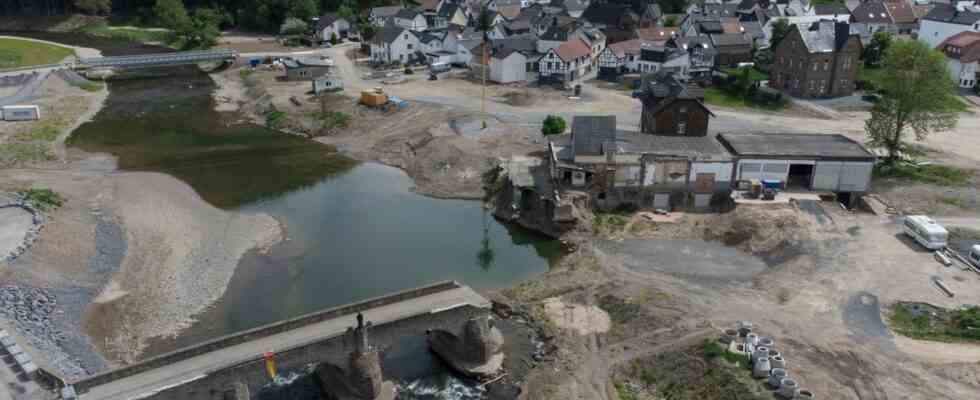When Olaf Scholz and Armin Laschet stepped in front of the microphones and cameras on August 3, 2021, two weeks after the flood of the century in Stolberg near Aachen, which was particularly badly hit, and gave their promise worth billions, the rain pelted down on them. At that time, the two politicians were still federal finance ministers and North Rhine-Westphalian prime ministers – and candidates for chancellor of their SPD and CDU parties.
In a speech that was unusually insistent for him, Scholz said on Kaiserplatz: What nobody can make up for is “the destroyed lives, the destroyed health and what the catastrophe has done in people’s hearts and minds”. Then he promised the thousands of people affected in Rhineland-Palatinate and North Rhine-Westphalia: “But what can be fixed with money, we will fix with money.” Shortly thereafter, the federal government decided on the largest aid package ever launched in the Federal Republic after a flood: 30 billion euros.
Politicians everywhere promised “unbureaucratic help”. But how unbureaucratic can and should the payment of 30 billion euros in tax money actually be? In NRW, the building ministry of Ina Scharrenbach (CDU), who has been in the NRW state government since 2017, is responsible for distributing the funds. Tens of thousands of people in almost half of all NRW municipalities were hit by the flood. Anyone who wants to know a year after the flood how much money has reached the people, the companies and the municipalities will only hear the phrase: “It was approved and is being paid out.”
A few days ago, Scharrenbach took stock, she said: “We are making really good progress, better than in the neighboring countries that were also affected.”
The NRW government finds its balance sheet good. Affected people see it very differently
She rejected criticism of the application procedure, which she felt was too complicated, saying that there had been many improvements in the early days, but now “it’s running smoothly”. On average, after the application has been successfully checked, it takes about nine days for the money to be transferred. According to Scharrenbach, 196 fraud attempts with a total volume of around eight million euros were foiled. Only about a quarter of the additional 280 jobs that the country had created especially for reconstruction aid could be filled.
Of the 12.3 billion euros that are available in NRW for reconstruction, only a small part has so far been used: around 1.6 billion euros for private individuals, companies, agriculture and cities are “in the process of being paid out”, like Scharrenbach. Of this, 483.4 million euros went to private households. Almost 19,000 applications were made, 94 percent of which have already been checked or approved.
The NRW consumer advice center sees Scharrenbach’s balance sheet differently. She announced last week that many people affected by the flood disaster were “frustrated and disappointed”. There is a lack of craftsmen, building materials and experts. The construction and material costs – especially for insulating materials – continue to rise, and even approved funds are not always readily available. In addition, numerous injured parties were not adequately insured.
Rhineland-Palatinate published a brochure on reconstruction for the anniversary, which first commemorates the 135 dead, the two people who are still missing. The damage is also measured there: A total of 65,000 people are affected, not only in the Ahr Valley, but also in the districts of Cochem-Zell, Mayen-Koblenz and in Trier. The Mosel destroyed houses – 18 billion euros in damage to buildings and roads in seven districts , line networks.
Of course there are those where everything worked out. But there are also the others
But of course the country also wants to show what has been done a year later: 9,158 of the 9,787 applications for help for the reconstruction of household goods have been approved. For buildings: 1578 out of 1909. For companies: 182 out of 265. A total of 538.4 million euros have been approved. Not bad, right?
In the villages, in Dümpelfeld, Insul and Schuld, the people answered immediately. Of course there are those for whom everything worked out, who say they can’t complain. But there are also the others. They complain that filling it out is too complicated, especially for older people, because you can only do it on the computer, because a lot of documents are needed, then you have ticked the wrong box and the application is hanging at the Investment and Structure Bank of Rhineland-Palatinate ( ISB) fixed. Another problem: Approved does not mean paid out, which was only 210.3 million euros.
It should be “quick and unbureaucratic”.
At the beginning of July, around 200 people demonstrated in Mainz, they had the feeling that the politicians had forgotten them, they wanted to remind them of this great promise with whistles and posters. “Where are the donations” was written on one of the signs, behind it: six question marks. State Finance Minister Doris Ahnen (SPD) tried to appease: When it comes to buildings, larger sums are involved, so it takes time.
At the ISB, they point out that 120 people take care of the construction aid, 60 of them the applications, and that a “higher manual effort” is necessary for those dealing with building damage. Those affected initially receive a down payment of 20 percent. For the next part of the money, they must provide a list of the bills they have incurred. Proof of use is required for the last part. Only then can the full amount be paid out.

